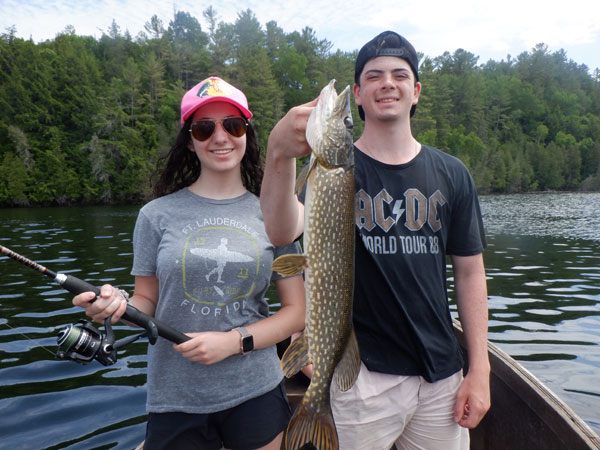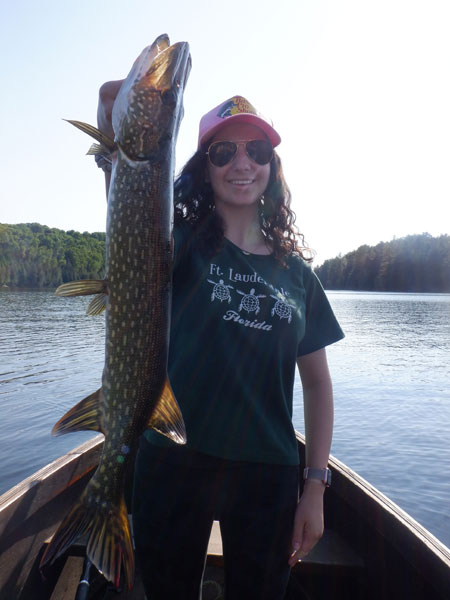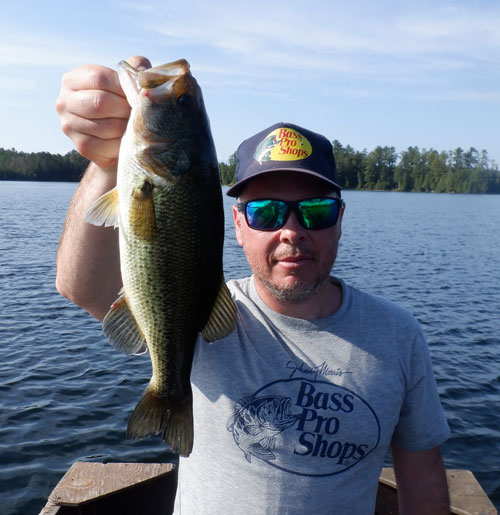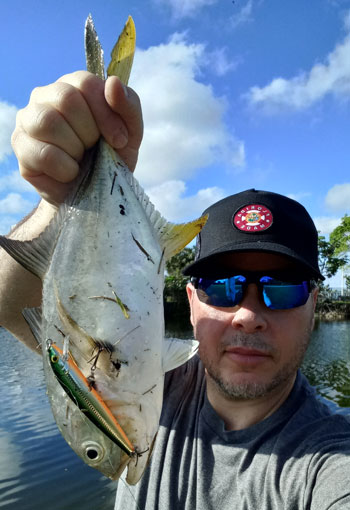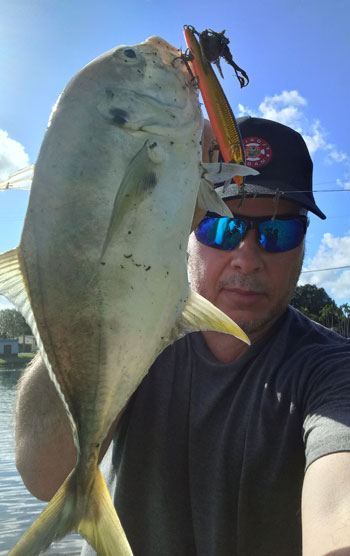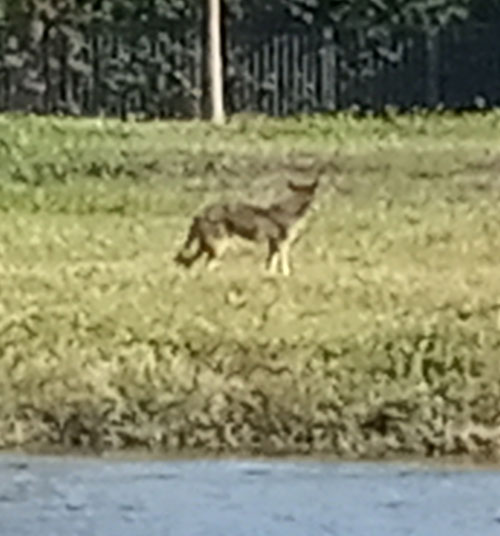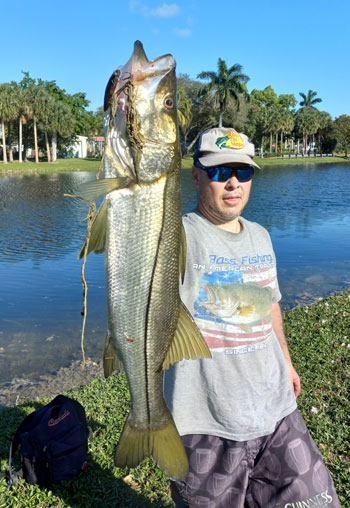After finding a last minute great deal on an airline ticket to Miami, I decided to forego my plans of chasing big bass on ice. Choosing between visiting my grandkids, daughter and son in law, were already a no brainer at that point. Being that she lives in North Miami beach, warm sunny weather, and potentially great shore fishing, were added bonuses. Without going into all the airlines issues and mishaps, I'll skip directly to the relevant fishing part of the trip I managed to pull off.
Day 1:
After missing out on a day of fishing due to delayed baggage, I was happy to get out and fish the c9 canal / snake creek trail / Royal Glades canal again. Having fished various segments of that canal over the past few years, I knew what I was facing. My daughter lives within less than 15 minutes walk to the c9 canal, which runs runs many miles inland from the the dam near Biscayne blvd.
Fishing Miami canals on foot, requires a lot of perseverance. High heat even during the winter, necessitates bringing along a few liters of drinking water, which are carried in a backpack throughout the day. T-shirts keep getting dunked in the water in order to stay cool, in addition to the cap I wear. Most of all, cardio and isometric training, along with a lot of stretching and some Ibuprofen at my age, go a long way to keep me walking and fishing many miles per day, for days on end.
After losing a nice snook that cut my line on the last trip, I picked up a couple Rapala Husky jerks, which was the lure that got cut off. Rapala Husky Jerks in models Tennessee shad Hj10 and Gold Hj12 were the newest weapons in my arsenal, courtesy of BassPro Shops. My new Penn Pursuit 4 reel, was spooled with hundreds of feet of braid, I tied on the new HJ10 to get started.
Immediately, I started getting tons of follows from largemouth and peacock bass. Literally a good 50 or so chasers in the first segment of canal I fished in the first 1/2 hour or so. Unfortunately no hookups. I crossed over Miami Gardens Rd, going into Sky Lake. Within a few casts, I got my first hit and hookup of the trip. To my great surprise, it was a small jack crevalle, my first ever saltwater fish in a freshwater canal. Nothing big, but a very welcome catch.
That turned out to be the smallest of any jacks landed during my trip to Miami. A few casts later, I hooked into a bigger jack, this time it was a rarer yellow jack. Note the different color pattern.
After working my way down a long stretch of the c9 canal along the Snake creek trail, I hooked my first freshwater fish of the trip, a small largemouth bass that hit the hj10 husky jerk.
I kept working my way West along the canal, until I reached the point of turning back. After dunking my t-shirt in the water for the n'th time too keep cool, I upsized my lure to the HJ12 Rapala Husky Jerk. Within a few minutes, I was into to my next jack crevalle, as sizes kept increasing.
I kept heading East along the snake creek trail, and within minutes, I noticed 2 big jack crevalles swimming right in front of me at high speed, along the clear waters of the shoreline. I cast well ahead of them, and with a seemingly perfectly timed retrieve, I manage to get hit by one of the big jacks.
Jacks are built for speed, and on the initial blistering run, this big jack took a good 200 feet of line off my reel, before I tightened down my drag enough to put the brakes on it. During the entire fight, the second jack of just about identical size, kept following the hooked fish. After eventually subduing the jack, it was now a matter of finding the best spot to land it. Fishing on foot with minimal gear and without a landing net, I had to find a spot along the steep bank, overgrown with shrubbery, and hiding potential water snakes. I found a spot were I was able to hop onto a big boulder protruding from the water, and land the big jack crevalle.

The jack ended up measuring 26 inches in length, probably a good 7-8 lbs, but didn't have my scale with me due to delayed baggage. Still, the power of a big and speedy saltwater species like jack crevalle, will make for a better fight than most freshwater species, especially on gear designed for bass. Definitely a fight and catch that I won't soon forget.
Working my way back to where I started, I landed my first peacock bass of the trip, completing my trifecta on the first day.
As I kept moving along, I hooked into another jack crevalle. Another decent fight right in front of the yeshiva.
After having landed 5 jacks, as well as both peacock and largemouth bass, I couldn't be happier with my first day of fishing the c9 / Royal Glades canal. My first day of landing multiple catches of saltwater species in freshwater, as well as both species of resident bass, had far exceeded my expectations. The size, power, and speed of the bigger jacks had made for some great drag ripping action, and I was stoked to see how well my plan for ripping jerk baits had proved to be successful.
Day 2:
After the previous day's success, I figured I'd stick with the same plan. Started off casting the bigger Hj12 husky jerk, and managed to hook another smaller jack, that popped off right near the shore, when I tried to hoist it out of the water.
As I crossed over the road to the next segment of canal, I came upon a few air and land predators.
First, a pair of protected / endangered burrowing owls:
Then, a big fox across the canal:
Along with a big flock of turkey vultures:
Eventually, back to fish species, another small largemouth bass landed, after I had switched back to the smaller hj10 husky jerk:
Followed by anther small jack crevalle.
Crossing under the 1-95 towards Sky lake, i connected with another peacock bass.
Moving East towards Miami Gardens road, another nice 18+ inch jack crevalle, right in front of Yeshivas Toras Chaim:
At this point, being that most of the jacks i caught were right near the yeshiva, I decided to rename the jacks. Jewish name for Jack is "Yaacov, or in Yiddish "Yankel". As such, all subsequent jacks caught on the trip would be "Yankels"...
Day 3:
The day started off much slower, again casting the hj10. Nowhere near the 50 of so follows I got from big peacock bass, mixed in with occasional largemouth bass. Jacks chased and swirled around my lure every now and then, but no actual hits. It seemed like the jerkbait magic had disappeared. Hitting my turnaround spot after a good 5 kilometers of trekking, I tied on the bigger hj12 husky jerk, but results weren't any better.
After 5 hours of so of fishing in the intense heat without a hit, I decided to trek over to a liquor store to stock up for Shabbat. Fished the other end of Sky lake for the first time on the way, with a couple more follows from peacock bass, but no hits. After stocking up on liquor, I headed towards home, figuring I had been skunked for the first time this trip.
On my way home, there was a tiny stretch of fishable canal that I was able to cast to. After having trekked a couple kilometers in the heat with a backpack filled with fishing gear, water, tequila, and a few liters of beer, I figured I might as well slow down and take a few casts. Sure enough, I noticed a small school of jacks swimming towards me. I ran ahead to head them off, and on my second cast, I got my first hit of the day. I hooked into the fish, and to my extreme surprise, I had hooked a big snook.
The snook was barely hooked to my lure's last treble hook, but as it came closer to shore and to the surface, I was able to embed more hooks into it as it tried to turn. At some point during the intense battle, my line ended up in it's gills. Fearing a repeat cutoff, I tried my best to carefully dislodge the line from it's gills, and luckily, I managed to do so.
The big snook kept digging down, using torque instead of speed, to avoid being landed. I took my time, enjoyed the battle, until the snook tired, and came into shore. Again, I had to find a landing spot along the steep bank of the canal in order to land it. When I did, I was amazed, and sort of frozen at that moment in time.
Some kid was passing by on his scooter on the bike trail along the canal, I handed him my phone to capture the moment.
The big snook ended up measuring 31 inches and weighing around 9 lbs. Note my 5 inch lure dangling from it's mouth. While I don't normally keep fish from the C9 canal, due to me fishing on foot without a cooler, nor being willing to haul around fish, spoiling in the heat all day while I keep fishing, this one was different.
For starters, I heard that snook were a real good eating fish. Luckily, I had researched the rules before heading out. The 31 inch snook was perfectly in the allowable slot size range of 28-32 inches, and with my luck, snook season had just opened to harvest a couple days before my trip. Lastly, I was within a 5 minute walk to my son in law's parent's house, to where I proceeded to head with my first harvested snook.
Luckily, they obliged, and I took a last pic with the big snook before dispatching and filleting it, as it was still alive when I got there.
I proceeded to fillet it outside, and had them fridge half of it for a dinner date a couple days later, and freeze the other half for later use.
Either way, I was very happy to land a new PB, as the other snooks I had previously hooked and caught in saltwater, were significantly smaller than this one.
Funny enough, I've always laughed at over dramatic fishing shows, where the hosts always seem to catch the biggest fish on the last day of the trip, or at the last minute of the show. Jeremy Wade from River Monsters and Cyril Chauquet of Catching Monsters come to mind.
In reality, it is quite rare for things to turn out the way these staged fishing shows present falsified content to their audiences, in order to keep them captivated. However, this time around, the snook catch was even better than pre-scripted, as I had already resigned to the idea of having been skunked that day, and was beyond belief at what had transpired.
Day 4:
After spending another long and memorable weekend with my daughter, son in law, grandchildren, and their in laws, I had planned to take my grandkids out to fish one of the piers for good numbers of pilchards and croakers, using a Sabiki rig. Unfortunately, my grandson got sick, and ended up bedridden, while my granddaughter ended up making a playdate with a friend that was moving out of town the following day.
Ending up with a few hours to kill, I headed out to do some more jerk bait casting on the c9 canal, at Snake creek trail. Landed one of two peacock bass, and lost a decent largemouth bass in the 15-16 inch range, that spit my lure just at the shore.
Peacock bass weren't the only type of peacocks encountered...
Ended the short outing speaking to another angler that advised me to head East towards saltwater to try to hook into more and bigger jacks the following day.
That evening, I headed over to my daughter's in law's place, to cook some of the snook. I ended up with a nice fillet around 18 inches long and maybe 2 inches thick. Enough to feed the 3 of us.
After cutting the fillet into portions, I hit half of them with egg wash and seasoned breadcrumbs, and the other half with a mix of Himalayan salt, fresh ground black pepper, garlic powder, and paprika. Pan fried them all in a hefty serving of butter, sprinkled with fresh squeezed lemon juice.
The snook was delicious, similar to striped bass, maybe a hint of snapper in the texture. Very moist and tender, with a mildly fishy taste. Definitely a meal I won't soon forget.
Day 5:
During my previous trip to Miami in November 2024, I trekked eastward along the c9 canal, towards the spot where the canal ends at a dam past Biscayne blvd. The canal gets cutoff by an uncrossable train track, so I didn't make it to the dam last time around. This time, I mapped the crossing to 163rd street, a few blocks from the canal. My plan was to fish my way up to the dam, and spend as much time as needed, once reaching the dam.
Fishing my way East was uneventful, with a few bigger peacock and largemouth bass swirling around my lures without hits. I eventually reached the dam, a relatively small area, with big schools of jacks of all sizes turning in circles.
Unfortunately, despite my casting heavily into the big numbers of fish in a tiny area filled with all sizes and numbers of jacks, I wasn't even able to get a follow, let alone a hit.
After a while and some frustration, I decided to head back, and fish the canal all the way past i-95, a good 5-6 miles of trekking. I eventually connected with another jack after a couple hours, only fish of the day. Pic seems to have disappeared from my phone. Ended the day throwing topwaters on Pickwick lake, first time of the trip I switched from jerkbaits. No success on topwaters either.
By far the most trekking of my trip, fishing a good 20 kilometers or so on foot.
Day 6:
My last day of fishing during this trip to Miami, I headed back to where I had most of my success over the past week of fishing.
I hit another jackpot within the first half hour or so, this time, in Pickwick lake right across Sky Lake. On my first cast to a given spot, I got followed by a big peacock bass, right up to shore. While this had already happened a good 50+ times during the last few days, I short cast my jerkbait again, twitched it a couple times, and got hit within less than 10 feet in front of me.
Within seconds, I landed my biggest ever peacock bass, and also the biggest fish I've managed to pull out of the tiny Pickwick lake, since first fishing it on foot a few years ago.
With that sort of success, may day was already made. It was my second PB of the trip, and I was hoping to get one more shot at a giant largemouth bass I had seen bedding the previous day, without being able to manage any hits, no matter what I threw at it.
Unfortunately, the big bass was no longer on the spot I marked near shore. I did manage to land another decent "Yankel" nearby.
I worked my way back home using the bigger hj12 husky jerk, that had provided most of the bigger catches of my trip. Started off landing my smallest largemouth bass of the trip:
Finally, on my way back, right in front of the yeshiva where I had landed landed my first catch of the trip a few days before, I connected with another very nice "Yankel", this time a 20 incher than put up another crazy fight.
Perfect end to a perfect trip, I packed it in early, in order to clean, break down, and pack up my gear, before heading home later that evening.
All in all, this was hands down my best DIY fishing trip to Miami, and possibly one of the better shore fishing trips I have ever achieved.
Catching a saltwater fish in a freshwater canal is an achievement in itself, but landing over double as many saltwater catches versus freshwater species, is crazy. To be exact, 11 jacks, 4 peacock bass, 3 largemouth bass and a big snook, as well as a few lost fish, from hundreds of follows in clear water. Let alone the bigger power and sizes, the high speed of jacks, and torque of the big snook, and a couple PB's to show for when it was all said and done.
Again, I thank my daughter and her husband for hosting and putting up with me, my wife, for allowing me to just hop on a plane and take off on a last minute whim, and most of all, God, for creating all the wonderful species I fish for, and for granting me the opportunity, health, time, and finances to afford to keep doing it, year after year.
Hope to be back on ice as soon a weather conditions permit.











